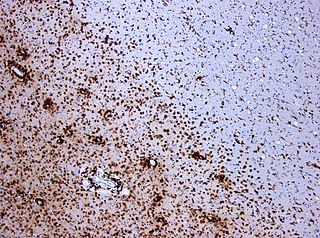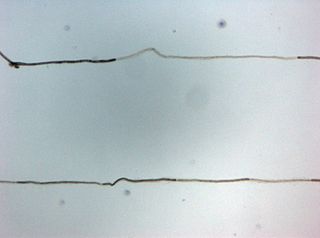Related Research Articles

Neurotoxins are toxins that are destructive to nerve tissue. Neurotoxins are an extensive class of exogenous chemical neurological insults that can adversely affect function in both developing and mature nervous tissue. The term can also be used to classify endogenous compounds, which, when abnormally contacted, can prove neurologically toxic. Though neurotoxins are often neurologically destructive, their ability to specifically target neural components is important in the study of nervous systems. Common examples of neurotoxins include lead, ethanol, glutamate, nitric oxide, botulinum toxin, tetanus toxin, and tetrodotoxin. Some substances such as nitric oxide and glutamate are in fact essential for proper function of the body and only exert neurotoxic effects at excessive concentrations.

Jamaica ginger extract, known in the United States by the slang name Jake, was a late 19th-century patent medicine that provided a convenient way to obtain alcohol during the era of Prohibition, since it contained approximately 70% to 80% ethanol by weight. In the 1930s, a large number of users of Jamaica ginger were afflicted with a paralysis of the hands and feet that quickly became known as Jamaica ginger paralysis or jake paralysis.

A demyelinating disease refers to any disease affecting the nervous system where the myelin sheath surrounding neurons is damaged. This damage disrupts the transmission of signals through the affected nerves, resulting in a decrease in their conduction ability. Consequently, this reduction in conduction can lead to deficiencies in sensation, movement, cognition, or other functions depending on the nerves affected.

Chlorfenvinphos is an organophosphorus compound that was widely used as an insecticide and an acaricide. The molecule itself can be described as an enol ester derived from dichloroacetophenone and diethylphosphonic acid. Chlorfenvinphos has been included in many products since its first use in 1963. However, because of its toxic effect as a cholinesterase inhibitor it has been banned in several countries, including the United States and the European Union. Its use in the United States was discontinued in 1991.

In organic chemistry, organophosphates are a class of organophosphorus compounds with the general structure O=P(OR)3, a central phosphate molecule with alkyl or aromatic substituents. They can be considered as esters of phosphoric acid. Organophosphates are best known for their use as pesticides.

Diazinon, a colorless to dark brown liquid, is a thiophosphoric acid ester developed in 1952 by Ciba-Geigy, a Swiss chemical company. It is a nonsystemic organophosphate insecticide formerly used to control cockroaches, silverfish, ants, and fleas in residential, non-food buildings. Diazinon was heavily used during the 1970s and early 1980s for general-purpose gardening use and indoor pest control. A bait form was used to control scavenger wasps in the western U.S. Diazinon is used in flea collars for domestic pets in Australia and New Zealand. Diazinon is a major component in the "Golden Fleece" brand sheep dip. Residential uses of diazinon were outlawed in the U.S. in 2004 because of human health risks but it is still approved for agricultural uses. An emergency antidote is atropine.

Neuritis, from the Greek νεῦρον), is inflammation of a nerve or the general inflammation of the peripheral nervous system. Inflammation, and frequently concomitant demyelination, cause impaired transmission of neural signals and leads to aberrant nerve function. Neuritis is often conflated with neuropathy, a broad term describing any disease process which affects the peripheral nervous system. However, neuropathies may be due to either inflammatory or non-inflammatory causes, and the term encompasses any form of damage, degeneration, or dysfunction, while neuritis refers specifically to the inflammatory process.

Diisopropyl fluorophosphate (DFP) or Isoflurophate is an oily, colorless liquid with the chemical formula C6H14FO3P. It is used in medicine and as an organophosphorus insecticide. It is stable, but undergoes hydrolysis when subjected to moisture.

Chronic inflammatory demyelinating polyneuropathy (CIDP) is an acquired autoimmune disease of the peripheral nervous system characterized by progressive weakness and impaired sensory function in the legs and arms. The disorder is sometimes called chronic relapsing polyneuropathy (CRP) or chronic inflammatory demyelinating polyradiculoneuropathy. CIDP is closely related to Guillain–Barré syndrome and it is considered the chronic counterpart of that acute disease. Its symptoms are also similar to progressive inflammatory neuropathy. It is one of several types of neuropathy.

Dichlorvos is an organophosphate widely used as an insecticide to control household pests, in public health, and protecting stored products from insects. The compound has been commercially available since 1961. It has become controversial because of its prevalence in urban waterways and the fact that its toxicity extends well beyond insects. Since 1988, dichlorvos cannot be used as a plant protection product in the EU.

Tricresyl phosphate (TCP), is a mixture of three isomeric organophosphate compounds most notably used as a flame retardant. Other uses include as a plasticizer in manufacturing for lacquers and varnishes and vinyl plastics and as an antiwear additive in lubricants. Pure tricresyl phosphate is a colourless, viscous liquid, although commercial samples are typically yellow. It is virtually insoluble in water, but easily soluble in organic solvents like toluene, hexane, and diethyl ether among others. It was synthesized by Alexander Williamson in 1854 upon reacting phosphorus pentachloride with cresol, though today's manufacturers can prepare TCP by mixing cresol with phosphorus oxychloride or phosphoric acid as well. TCP, especially the all-ortho isomer, is the causative agent in a number of acute poisonings. Its chronic toxicity is also of concern. The ortho-isomer is rarely used on its own outside of laboratory studies that require isomeric purity, due to its extremely toxic nature, and is generally excluded from commercial products where TCP is involved.

Organophosphate poisoning is poisoning due to organophosphates (OPs). Organophosphates are used as insecticides, medications, and nerve agents. Symptoms include increased saliva and tear production, diarrhea, vomiting, small pupils, sweating, muscle tremors, and confusion. While onset of symptoms is often within minutes to hours, some symptoms can take weeks to appear. Symptoms can last for days to weeks.
Progressive inflammatory neuropathy is a autoimmune disease that was identified in a report, released on January 31, 2008, by the Centers for Disease Control and Prevention. The first known outbreak of this neuropathy occurred in southeastern Minnesota in the United States. The disease was reported among slaughterhouse workers who appeared at various care facilities in the area reporting similar neurological symptoms. The disease was later identified at slaughterhouses in Indiana and Nebraska as well. The condition is characterized by acute paralysis, pain, fatigue, numbness, and weakness, especially in extremities. It was initially believed that workers might have contracted the disease through inhaling aerosols from pig brains that were created by a machine at the slaughterhouse and that an autoimmune response to the particles might have produced their mysterious peripheral neuropathy. These suspicions were confirmed in reports and investigations conducted at the Mayo Clinic in Rochester, Minnesota.

Acetylcholinesterase inhibitors (AChEIs) also often called cholinesterase inhibitors, inhibit the enzyme acetylcholinesterase from breaking down the neurotransmitter acetylcholine into choline and acetate, thereby increasing both the level and duration of action of acetylcholine in the central nervous system, autonomic ganglia and neuromuscular junctions, which are rich in acetylcholine receptors. Acetylcholinesterase inhibitors are one of two types of cholinesterase inhibitors; the other being butyryl-cholinesterase inhibitors. Acetylcholinesterase is the primary member of the cholinesterase enzyme family.
Aerotoxic syndrome relates to ill-health effects associated with breathing contaminated air in an airliner cabin. Researchers have associated aerotoxic syndrome with exposure to substances such as engine oil and hydraulic fluid. Although researchers have identified correlations between the aircraft occupational environment and symptoms of aerotoxic syndrome, this condition is not an established medical diagnosis because the incidence and aetiology of the condition are still under debate.
Neuropathy is a condition affecting the nerves of the peripheral nervous system.

A fume event occurs when bleed air used for cabin pressurisation and air conditioning in a pressurised aircraft is contaminated by fluids such as engine oil, hydraulic fluid, anti-icing fluid, and other potentially hazardous chemicals.

Neuropathy target esterase, also known as patatin-like phospholipase domain-containing protein 6 (PNPLA6), is an esterase enzyme that in humans is encoded by the PNPLA6 gene.
Megavitamin-B6 syndrome, also known as hypervitaminosis B6, vitamin B6 toxicity, and vitamin B6 excess, is a medical condition characterized by adverse effects resulting from excessive intake of vitamin B6. Primarily affecting the nervous system, this syndrome manifests through symptoms such as peripheral sensory neuropathy, characterized by numbness, tingling, and burning sensations in the limbs. The condition is usually triggered by chronic dietary supplementation of vitamin B6 but can also result from acute over-dosages, whether orally or parenterally.
References
- ↑ Morgan, John P; Penovich, Patricia (August 1978). "Jamaica Ginger Paralysis: Forty-seven-year follow-up". Archives of Neurology. 35 (8): 530–532. doi:10.1001/archneur.1978.00500320050011. PMID 666613.
- ↑ Segalla, Spencer David (2020). "Poison, Paralysis, and the United States in Morocco, 1959". Empire and Catastrophe: Decolonization and Environmental Disaster in North Africa and Mediterranean France Since 1954: 78–107. ISBN 9781496219633. JSTOR j.ctv10crdt6.7.
- ↑ Ehrich, Marion; Jortner, Bernard S (2010). "Organophosphorus-Induced Delayed Neuropathy". Hayes' Handbook of Pesticide Toxicology. pp. 1479–1504. doi:10.1016/B978-0-12-374367-1.00069-0. ISBN 978-0-12-374367-1.
- ↑ Qiang, D; Xie, X; Gao, Z (2017). "New insights into the organophosphate-induced delayed neuropathy". Journal of the Neurological Sciences. 381: 153–154. doi:10.1016/j.jns.2017.08.451. S2CID 54302903.
- ↑ "Cholinesterase Inhibitors – Organophosphate-Induced Delayed Neuropathy (OPIDN)". ATSDR – Environmental Medicine & Environmental Health Education –CSEM (CDC). March 2022.